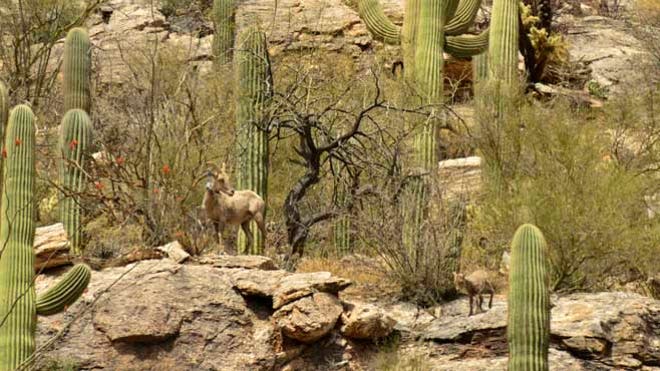I reproduce the text of the article, because headlines and links disappear over the years.
As we consider most bighorn-sheep related news to be important, we archived the report here.
Commentary on the article will come from us soon.
***
http://www.foxnews.com/science/2014/03/23/bighorn-sheep-conservation-arizona-mountain-lion-catalina/
***
Some animal welfare groups are pushing for an end to the project, but wildlife officials say the conservation effort is not a failure and expect the projected $600,000, three-year plan to result in greater numbers of bighorns in an area where they once co-existed with mountain lions for centuries.
Deaths of bighorn sheep in Arizona spark controversy over conservation effort
The issue, say Arizona wildlife officials and biologists, is a complex one.
Bighorn sheep, a gregarious, herd-forming species, once thrived in large numbers across the western U.S. until their population dropped dramatically over the past 100 years -- for reasons biologists continue to study, such as disease, fires or loss of water source. Wildlife officials in Arizona estimate the current count to be around 6,000 in the state, and they are working with conservationists to rebuild a herd that disappeared from the Tucson range in the 1990s.
Last November, the Arizona Game and Fish Department implemented the first phase of a three-year plan to transplant the creatures from the Yuma area into the Catalinas, where they once lived. Wildlife officials in the state said they spent $150,000 -- none of which was taxpayer money -- to catch 31 bighorns by helicopter, place satellite transmitter collars on them and transport the herd to the Santa Catalina Mountains just north of Tucson.
Four months later, 15 of the bighorns had been killed by mountain lions that thrive in the area -- leaving some animal welfare advocates to question whether such a plan was prudent on the part of an independent panel formed by state wildlife officials.
The Catalina Bighorn Advisory Committee -- comprised of groups such as the Arizona Desert Bighorn Sheep Society, the Wilderness Society and the Center for Biological Diversity — had recommended that officials not kill any mountain lions prior to the transplant of bighorns.
After nearly half the bighorn herd was killed, state wildlife officials in turn killed two mountain lions -- leading to protests by individuals who claimed the big cats should not be targeted for acting as natural predators in the wild.
An editorial published last December in the Arizona Republic posed a question at the heart of the controversy: "Re-creating a bighorn population in the Catalina Mountains is a good goal that may result in the loss of some individual animals. How many are too many? When does the project cross the line from ambitious and worthy to sacrificial and cruel?"
The Arizona Game and Fish Department and its supporters stand by the transplant decision, although Jim Paxon, special assistant to director Larry Voyles, said "in hindsight, we should have taken out some mountain lions."
"Conservation of wildlife is never easy, never quick and is often what biology professors call messy," Paxon told FoxNews.com. He said the plan moving forward is toassess areas in the Catalinas where the bighorns have the greatest chance of survival and place additional sheep there in the fall. He said the hope is that the remaining bighorn transplants and their lambs will move toward the new herd. Paxon also said some mountain lions near the determined location will be killed, but stressed that officials are not planning a "wholesale removal of mountain lions across the Catalinas."
"All we’re doing is removing mountain lions that prey on bighorn sheep in the best habitat area for those sheep," he said, adding that the mountain lion population is "not only healthy, it's thriving and expanding."
Critics, however, say the current plan should be stopped immediately.
"I don’t think that they really thought this out," said Ricardo Small, of the group Friends of Wild Animals, adding that, "this decision was pushed by hunters."
"The response to mountain lion killings of bighorn sheep has been to kill the mountain lions.
That's a mistake," Small said. "When competition among mountain lions is removed, the litter sizes of the females increase and the result is more mountain lions than were there to begin with."
"I think that the Arizona Game and Fish Department should stop this program completely. It's a waste of bighorn sheep and a waste of mountain lion."
But supporters of the group claim it's premature to abandon efforts to rebuild a population that once thrived in the Catalinas.
Kevin Murphy, conservation director of the Wild Sheep Foundation, called the bighorn deaths "frustrating," but said he was fully supportive of the plan in place. He also noted that the transplanted herd successfully birthed lambs and said more are expected in the coming months.
"Wildlife management is not a perfect exact science," Murphy told FoxNews.com. "You can't measure the success yet. It’s designed to be a three-phase release."
***
